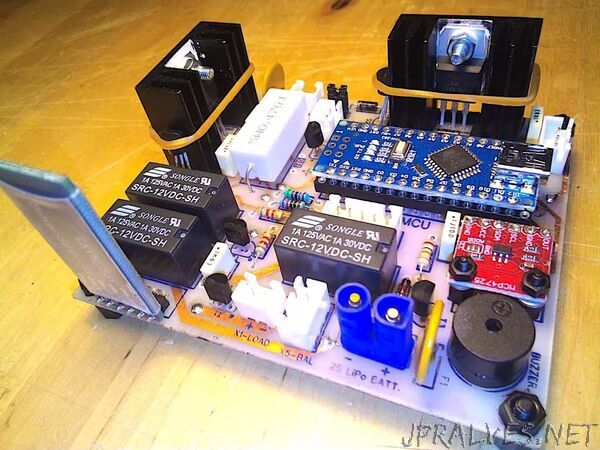
“For 2s1p (7.4V) battery packs, it does balancing, ready for a load circuit.
I would introduce to you this charger for Lithium Polymers (Li.Po.) batteries. It does support 2s1p battery packs, two 3.7V elements in series, 7.4V in total. The charger does balancing, it means it recharges a single element at a time to have a better final result.
Something about Li.Po. batteries:
This kind of batteries got two cables: one is for discharging (you connect the “load” here, 2 wires, thicker) and the second is for recharging (you connect the charger here, 3 wires, thinner). Both cable are to be connected to the charger. If you have a “load”, your circuit or appliance to connect to the battery, you have to use the X1-LOAD two wires (+) (-) connector available on board; because of the fuse dimension the current should not go over 2.5A.
WARNING: do not punch, cut or damage this kind of batteries. Do not discharge below 3.2V (better 3.4V), do not recharge over 4.2V. About discharging level is up to you and your “load”. If you do not take care of these advices you seriously risk to ignite your house and burn everything. These are general characteristics of Li.Po. batteries! Do not let alone the battery during recharging. Better is to store a Li.Po. battery in a fireproof bag to throw away in case of fire.
The circuit:
This charger takes care of the battery, it does not recharge more than 4.2V. It takes under control the temperatures by the way of voltage regulators heatsinks and a small fan. We put 3x TMP36 temperature sensors on voltage regulators uA7812 and LM317, one remotely on the battery (see X7-S3 connector). Ones the temperatures increase over attention threshold the fan starts; even more temperature it starts the “slowdown” (less charging current); still more temperature it starts 100% fan speed, stops recharging and play sound alarm. It got a buzzer for sound alarm, LEDs status and bluetooth telemetry. When you connect the external power to the charger it disconnects the load by the way of a relay: it is necessary to disconnect the load completely to not have interferences during the recharge and, very important, because the GND (-) of the load, and the charger as well, must be separated of the GND (-) of the battery during balancing/recharging. The picture below show you the 3 wires cable are connected to the two battery elements (cells) in series, it means the central wire works as minus (-) and plus (+) it depends of the case. The GND (-) is floating, it doesn’t exist an easy “common ground”.”
